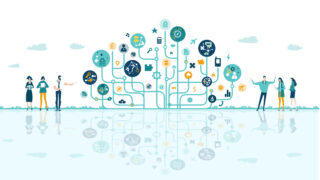You like being right. It’s OK—everyone does. Being right has psychological benefits, as well as practical ones: it makes us feel like we understand the world, like we know what we’re doing. It gives us a sense of feeling grounded in reality, successful, even talented.
But as Neil deGrasse Tyson warns, “The urge to feel special knows no bounds.” No one is completely free of that urge, but if we allow ourselves to sink into it, we invite narcissism, egocentrism, and cognitive bias.
Wanting to be right, in other words, can make us more likely to be wrong.
In business, cognitive bias can lead companies down destructive and costly paths. Leaders need weapons to fight back against bias. The most powerful weapon in that fight? Critical thinking.
Next Article
The Logic Tree: The Ultimate Critical Thinking Framework
9 Technology Myths: Reprogramming Business Leaders for the Future
What is cognitive bias?
Cognitive bias happens when the human brain tries to interpret reality without using logic. It’s a tricky animal because 1) it takes many forms, and 2) it operates largely in the background, creeping in through your subconscious. Even if you’re just making a random guess, cognitive bias can make you believe you’re showcasing hard-won expertise.
The result of cognitive bias is your very own subjective version of reality.
The Good Side of Cognitive Bias
Mental biases aren’t always a bad thing. As humans, we all have a core need to feel that we are right, good, and worthy. Cognitive bias actually services that need in some healthy ways.
Bias plays a role in how we build self-esteem, a moral compass, and a sense of identity. Some forms of cognitive bias, like apophenia (more on this below) spur creativity and imagination. Others, like person-positivity bias, help us see the best in people (because we want to project our own best qualities).
But too often, cognitive biases do us more harm than good.
The Bad Side of Cognitive Bias
Negative outcomes of cognitive bias can include discrimination, bigotry, and aggressive ignorance. Perception bias is a prime example, as it leads us to equate our assumptions with fact. That’s obviously a pretty slippery slope.
“There are all manner of cognitive biases. There are some that are particularly insidious if you’re trying to understand what is objectively true.”
NEIL DEGRASSE TYSON
Here are a few of the most common forms of cognitive bias that businesspeople, in particular, need to watch out for—and some critical thinking steps to thwart them.
- Apophenia
- Confirmation bias
- Sampling bias
- Survivorship bias

Apophenia
See if you can solve this riddle: A shepherd living in Northern Ireland has two sheepdogs. It’s been raining for three days. How many sheep does he have?
Did you solve it? Of course you didn’t. This “riddle” is unsolvable. It’s less a puzzle than it is a jumble of random information. Still, our brains assume there must be hidden connections: Why three days? Why Northern Ireland?
The tendency to look for patterns that aren’t there is a kind of bias. It’s called apophenia, and you do it all the time.
If you’ve ever looked at a cloud and thought, “Hey, that looks like a fluffy bunny!” or heard a story of someone seeing the face of Jesus in their toast, that’s apophenia. In the context of riddles, clouds, and toast, of course, it’s pretty harmless.
But apophenia is also where conspiracy theories come from.
In business, we need to take counteractive measures against conditions like apophenia. Imagine setting up a whole new marketing campaign based on what turns out to be random data. That could cost your company a lot of money—and cost you your job.
3 Critical Thinking Steps to Avoid Apophenia
- Don’t get carried away by false positives. If you’re basing a decision on data, make sure you gather that data systematically. Check benchmarks. Test and retest your findings before acting on them. If something seems too good to be true, it very well might be.
- Praise teams with inconsistent results. Supporting a team only when it does well may result in phony smiles, a hesitation to share bad news, and a false impression that praise leads to better work performance. Help your team assess their ups and downs.
- Beware big data hubris. It’s hard to wrap your head around how big big data actually is. Your brain will naturally (even desperately) start searching for connections anywhere and everywhere. Make use of trained, data-savvy managers to ensure your big data isn’t bad for business.
Confirmation Bias
Similar to perception bias, confirmation bias is the tendency to look for information that supports something you already believe, even if it means ignoring data that disproves that belief.
It’s easier than ever to fall for confirmation bias in the digital age.
Google will happily help you find evidence that the earth is round. Or flat. Or all kinds of other shapes. And social media algorithms don’t help—most people know Facebook curates content based on user preferences, essentially feeding the confirmation bias beast.
Every businessperson needs a learning mindset. It’s human to learn, be wrong, and relearn. It’s superhuman to be proven right at every turn. An important part of critical thinking is rethinking. Even scientists resist taking facts at face value, and they’re the ones coming up with the facts!
“Much like Santa Claus and unicorns, facts don’t actually exist. At least not in the way we commonly think of them.”
Julia Shaw, Author of The Memory Illusion
3 Critical Thinking Steps to Combat Confirmation Bias
- Accept that your opinions are not facts. If you find yourself talking to someone—anyone—who believes you’re mistaken, listen to what they have to say. Then check some credible sources. Be ready to be wrong.
- Entertain the possibility that you’re dumb. Smart people are more susceptible to confirmation bias because they’re used to being right. If you feel like you’re the smartest person in the room, try to assume the opposite. Listen to the diverse opinions around you and ask questions to explore new perspectives.
- Understand that your past success has nothing to do with tomorrow. In a world of constant change, old lessons lose their reliability by the second. And yet, it’s the oldest lessons we tend to rely on. Remember that experience is one thing—patterns are another.

Survivorship Bias
Imagine you’re feeling stuck in your career, so you head to the bookstore and browse the business section for some advice. A few names catch your eye: Elon Musk, Mark Zuckerberg, Sheryl Sandberg. You hardly even notice the hundreds of other biographies. Why? Because these are the men and women who ran the gauntlet and succeeded, like you want to. They can surely teach you something the others can’t.
You’ve just had your first lesson in survivorship bias.
Survivorship bias is the tendency to draw conclusions based on the people or things that “survived” some kind of trial, like weathering the tough world of business. But let’s face it: Musk, Zuckerberg, and Sandberg are one in a million. You’d have to beat astronomical odds to replicate their success, even if you studied every move they ever made. And you’ll never know how many would-be titans did use those moves but failed anyway.
There are loads of lesser-known men and women who can give you advice better scaled to your needs, but you won’t find them if you’ve got your survivorship bias goggles on.
If your team or company chooses to do something just because a big name did it, you may be headed for trouble.
3 Critical Thinking Steps to Survive Survivorship Bias
- Use benchmarks wisely. If your startup is a budding fashion boutique, don’t try to copy Chanel. By all means, study their early success for inspiration. But don’t forget Chanel was founded in 1910—a lot has changed since then!
- Look beyond results to holistic circumstances. Bill Gates, one of the richest men in the world, never graduated from university. Does that mean education is useless? Gates had two years at Harvard before dropping out, and he likely learned something in that time. Consider everything that went into a “survivor’s” success, not just the flashy headlines.
- Challenge your data. Survivorship bias thrives on shaky sources and rushed data analysis. Make sure you have real tools in your hands when you make decisions, not random Wikipedia pages from a quick Google search.
Sampling Bias
Imagine there’s an outbreak of a virus that makes dogs insatiably playful. Desperate for a cure (and some sleep), a team of scientists collects blood samples from every purebred dog in every dog park in New York City. Within a week, they have a hypothesis about which dogs are and aren’t carriers of the virus.
But that hypothesis is inevitably flawed due to sampling bias.
Sampling bias is the tendency to base conclusions on the information in plain sight. It also involves placing more weight on some members of a population than others. In the case of the playful pup virus, dogs that don’t go to dog parks had no representation. Neither did mixed breeds.
In business, sampling bias can hopelessly skew your data and give you a false sense of security. Defective products, for example, may only be reported by customers who can afford to mail them back.
3 Critical Thinking Steps to Sidestep Sampling Bias
- Start with a plan—and don’t forget it. Sampling bias happens during the action stage, so before you act, clarify your objectives, needs, and strategy. Then use those to measure each action before you take it.
- Remember that words have power. Surveys are a magnet for sampling bias. Careful wording and psychology should guide your way. Even too many options (a 1–10 scale instead of a 1–5 scale, for example) may have respondents listing toward a happy middle because they’d rather not commit to “strongly agree” or “strongly disagree.”
- Think random. Random sampling is a popular method for avoiding sampling bias because it equalizes the odds. If you’re forced to go with the pool of respondents most readily available—a method known as convenience sampling—be aware that your results will almost certainly be tainted by sampling bias.
Betting against Cognitive Bias
Critical thinking skills are the best way to safeguard yourself against cognitive bias in all its forms (not just these four) and stop relying on mental shortcuts. They can even help you harness the power of bias for good: Apophenia can nourish creativity, for example, and confirmation bias can boost self-esteem.
You’re not a superhuman with all the answers—and that’s OK. It’s also OK to enjoy the buzz of being right. But eventually, you’ll need to shake it off and apply a little logic as a critical thinker. Find out why you were right this time so you can be right next time, too.





